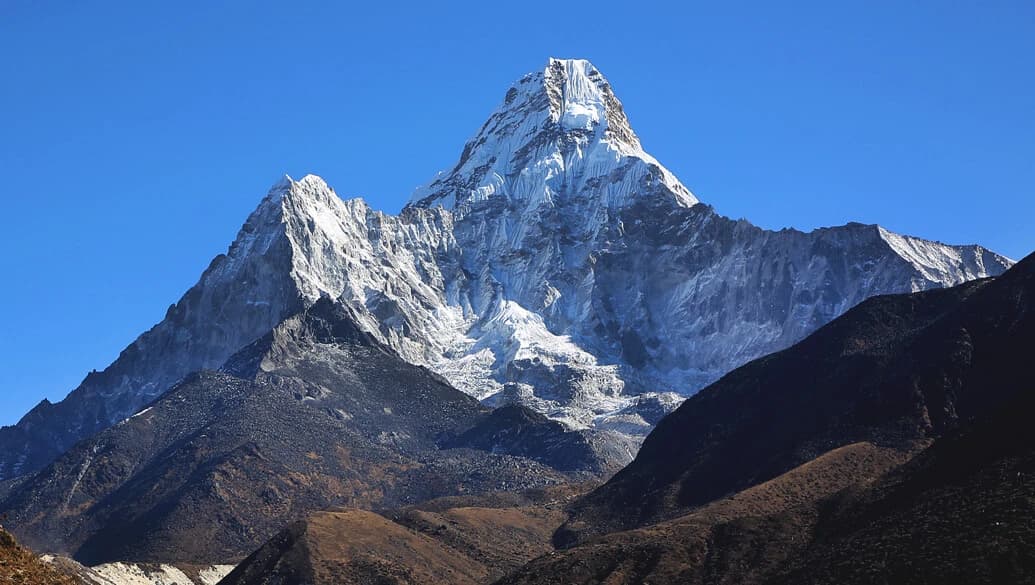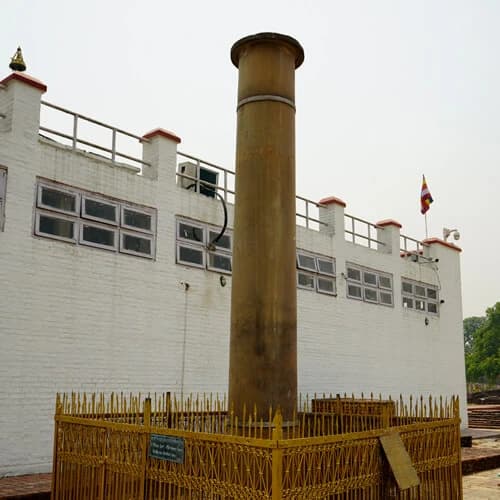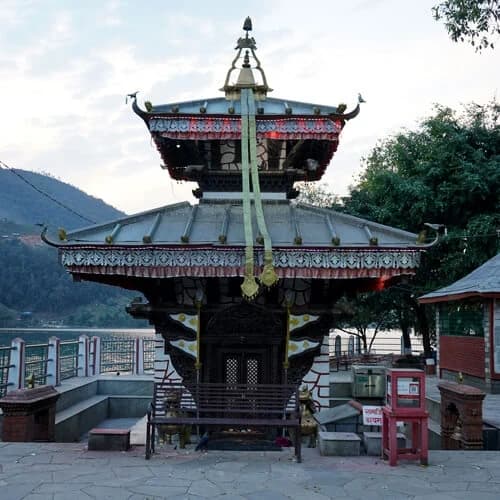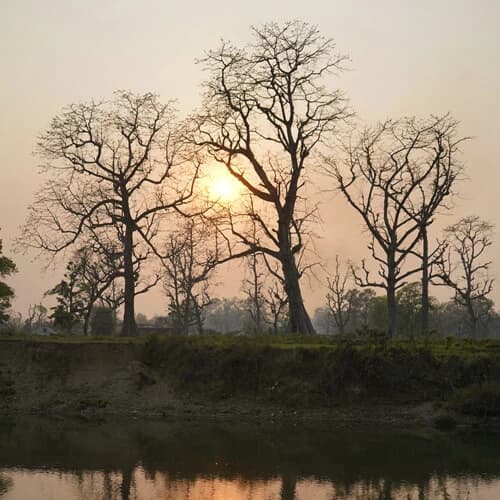Best Features of Ama Dablam Autumn Expedition
- Climbing one of the Himalayas' most breathtaking peaks
- Scaling 6812 meters tall mountain peak, which is a difficult summit to scale
- Taking in the magnificent view of Mount Everest, Mount Lhotse, and other peaks from the summit
- Trekking in the enticing Everest region before and after the ascent
- Exploring the Sagarmatha National Park's unusual flora and wildlife
- Learning about the vibrant Sherpa culture and their heroism in the mountains
- Spotting several climatic and geological changes in a single outing
- Breathtaking views of the Rhododendron's red and pink blooms covering the forest
Mount Ama Dablam Expedition in Autumn Overview
Mount Ama Dablam (6,812 m) is lodged 152 kilometers northeast of Kathmandu in the eastern Himalayan Range. Adjacent to the peak, there's a smaller peak located nearby (6,170 m). Typically, three camps are established along the southwest ridge, with Camp III located beneath the hanging glacier (the Dablam). Its peculiar shape appeals to climbers.
Despite its elevation of 6812 meters, the summit of Ama Dablam is not for amateurs. It takes technical skill to reach the top of the Ama Dablam peak. It offers every impossible task: ice, rock, scrambling, etc. Ama Dablam's base camp is superbly placed in a meadow with a stream. To partake in this Ama Dablam expedition, all climbers must be technically proficient and have excellent rock and ice climbing skills.
The name Ama Dablam means "Mother's Jewel" in English. Its name comes from the locals' perception that a glacier on its southwest side resembles "Dablam," a traditional Sherpa diamond, and "Ama," which means mother. The top of Ama Dablam has a remarkable allure. Each year, Ama Dablam attracts hundreds of climbers because of its beauty and challenges. Every climber strives to get to the top of Ama Dablam. If you have any prior experience and wish to be a part of a well-led expedition, Ama Dablam Autumn Expedition with Outfitter Nepal is your best option.
Since its first ascent, this 6812-meter-high mountain has grown in popularity with adventure enthusiasts as hundreds of climbers journey to its base to reach the peak of this stunning mountain. You can get a breathtaking 360-degree view of the surrounding mountains from the summit of Mount Ama Dablam, including the highest mountain in the world, Mount Everest (8848.86 m), the third-highest mountain, Mount Kanchenjunga (8586 m), the fourth-highest mountain, Mount Lhotse (8516 m), the fifth-highest mountain, Mount Makalu (8463 m), Thamserku, Khantega, and many other mountains.
This autumn, let's climb Mt. Ama Dablam with Outfitter Nepal for a thrilling adventure! We are taking reservations for our Ama Dablam Expedition in the autumn of 2023 and 2024. Our skilled and qualified Sherpas will lead you to the summit of the rigorous Mount Ama Dablam as a part of our Autumn Expedition! Your safety is our top priority, and bearing that in our mind, we have carefully designed the autumn itinerary.
History of The Ama Dablam Expedition
The first ascent of Mount Ama Dablam took place in 1961. Mike Gill (New Zealand), Barry Bishop (USA), Mike Ward (UK), and Wally Romanes (New Zealand) made the first ascent of Mount Ama Dablam on March 13, 1961, after spending the winter at 5800 meters near the peak to acclimate. They conquered this difficult peak from the Southwest Ridge. Those courageous mountaineers had taken part in the Sir Edmund Hillary-led Silver Hut Expedition in 1960 and 1961; thus, they were accustomed to high elevations and had acclimated well.
Which Climbing Route do we follow for the Ama Dablam Expedition in Autumn?
Every time we plan to climb Ama Dablam, we make sure to allow enough time for acclimatization. Our expedition crews gather food supplies, climbing gear, and other requirements at base camp. We will start from this base station and attempt to reach the peak. The expedition initially takes the standard Everest Base Camp trail to a particular point and then follows the trail towards Ama Dablam Base Camp.
The Southwest Ridge of Mount Ama Dablam is the traditional and most used climbing route. Ama Dablam, a 6812-meter-tall snow-capped peak in the Everest region, is one of the trickiest and most challenging mountains to climb. The path to its peak is lined with hard ice rocks and steep snow. Mountaineers typically have to set up a three-story camp before ascending.
The tough route, with saddle ridges, leads to Camp I. Then, turning to the north, we should ascend through the boulder and the stony ground. We arrive at Camp I at last. From here, one must traverse a rocky bowl and ascend a ridge using fixed lines to Camp II.
From Camp II, the route is steep mixed alleyways of rock, ice, and snow that lead to the steep climb and lead to snow ground that passes through steep snow and ice tunnel and finally proceeds along the snow ridge to Camps III. From here to the summit, the ascent is an arduous climb on snow and ice to the right of a huge hanging glacier. From the summit of Mount Ama Dablam, we can glimpse the Khumbu Himalayan, Makalu (8463 m), Island Peak, Lhotse (8516 m), Mount Everest (8848 m), and other snow-covered mountains.
Alternative routes to Ama Dablam Peak include the following:
North Ridge: This route was initially attempted in October 1979 as a substitute for the southwest ridge. It is not advisable to take this route, despite its breathtaking views. This is due to the increased likelihood of avalanches and the snow's propensity for being extremely unstable on the east face.
East Ridge: This straightforward ridge is believed to be one of the trickiest routes to Ama Dablam. The name Lagunak Ridge is sometimes used to describe this route by locals. This trail was only ascended for the first time in 1983.
Lower Ridge: Southern face of the mountain is where you'll find the Lower Route. This was the second route that was successfully climbed in April 1979 after the Southwest Ridge Route.
How safe is the Ama Dablam Autumn Expedition?
The climbing stage may, at times, be brutal and severe. Considering Mount Ama Dablam's elevation alone, there is a substantial risk. This fatal peak raises questions because high elevations gradually diminish their oxygen supplies. The most crucial phase of mountain climbing is the recovery interval following summiting, also called the acclimatization phase. Therefore, the acclimatization phase should be treated seriously. Due to the mountain's rough terrain, climbers find Ama Dablam more challenging than other higher peaks.
But for serious climbers, Ama Dablam is the most worthwhile peak to climb. The mountain is incredibly daring and dangerous due to its hazardous terrain, technical challenges, accessibility concerns, unpredictable climate, and avalanches. Before tackling the ascent of this treacherous mountain peak, every climber should be well-prepared and in top physical condition.
What are the Difficulties of the Ama Dablam Autumn Expedition?
The difficulty level for the Ama Dablam Expedition is TD/5 (Alpine / Grading Fitness link). To put it simply, it is a challenging summit. Ama Dablam Expedition is a technically difficult and taxing trip, although it is an altitude-friendly climb in comparison to other higher summits. There are numerous brief, high sections of the trail, along with practically vertical ice and rock on the lovely ridge that runs between Camp I and Camp II. High Camp-I is easy to climb. However, the route from High Camp II is mainly composed of sloping rocks, snow, ice glaciers, etc. This might be difficult for climbers, but it's not impossible. To reach the peak, climbers must endure a protracted and challenging trip over a glacier of snow and ice that requires great skill and strength.
Altitude sickness is another potential side effect of traveling in the Himalayas. Avalanches and falls are additional unpredictabilities that climbers in the Everest region need to cope with. As a result, even with a shorter ascent, Ama Dablam still presents a significant risk.
How to Prepare for the Ama Dablam Expedition in Autumn?
To attempt to climb Mount Ama Dablam, you should have high-altitude experience in addition to practical knowledge and technical proficiency. Expeditions should allow more time to adapt in the Himalayas since Ama Dablam requires sufficient acclimatization days.
The mountain peak is graded 5.7, but it might seem much more difficult. Be patient and calm as you negotiate the challenging perils that some of the ice's cruxes on your ascent may provide. Although some sections of the route may have a very flat grade, we suggest you use safety precautions and rope up when necessary.
It is extremely challenging to imitate vertical climbing in training, such as the legendary "Yellow Tower," which you must climb before ascending Camp II. Strength, core, and endurance exercises should be your main focus. Any cardiovascular exercise can be chosen, including jogging for long distances (10–20 km) three to four times a week, cycling for an hour or two, and hiking uphill while carrying 15-20 kg of weight. You should begin training at least 5–6 months before your climbing expedition.
A prime example of a helpful course is an Advanced Climbing Class. You will learn technical skills, including how to abseil safely, climb with a rope on five or six anchor points using ascenders, and use crampons to navigate ice, snow, and rock.
All potential climbers should be knowledgeable in the aforementioned mountaineering skills, capable of supporting themselves while climbing with an ice axe, and capable of abseiling from a height utilizing the safety rope of the route. A few mishaps occurred on this route due to the climbers' improper abseiling rope tying off at the bottom to the subsequent re-belay. The climbers should be ready for a long descent after reaching Ama Dablam because this is when most accidents occur on this expedition.
What is the cost of the Ama Dablam Expedition in Autumn?
The cost of the Ama Dablam Expedition varies on a number of factors. The prices that various trekking and mountaineering companies charge are based on the services they provide. Local businesses offer a better range of prices than foreign ones because no middleman commission is involved when booking with a locally-based group. The size of the grouping also impacts the cost. There can be group discounts available if the group is big.
We provide top-notch, all-inclusive services focusing on safety, a successful summit approach, and first-rate base camp help. These services include one-on-one climbing assistance, regional tour guides who impart their expertise on local history and customs, and an emphasis on safety. After careful consideration, we have decided on an advantageous expedition charge for both you and us. The price for the Autumn Ama Dablam Expedition at Outfitter Nepal is US$ —.
Why go for Ama Dablam Autumn Expedition with Outfitter Nepal?
We at Outfitter Nepal are aware that a well-planned schedule and tactical logistics are essential for the success of the Ama Dablam Expedition. We are dedicated to ensuring the climbers' safety and the effectiveness of the mission through our top-notch service. Our crew is dedicated to being a responsible, moral, and environmentally conscientious mountain adventure operator so that climbers can enjoy their climbing experience fully.
We emphasize keeping the group size modest because it makes it easier for everyone to coordinate and work together. Some of the best mountaineers in the business who have successfully ascended Ama Dablam will be in charge of your expedition. They have extensive training and knowledge. The years of summit achievement provided by our guides, Sherpas, and support staff have shaped our approach to mountaineering. You're safe with us.





